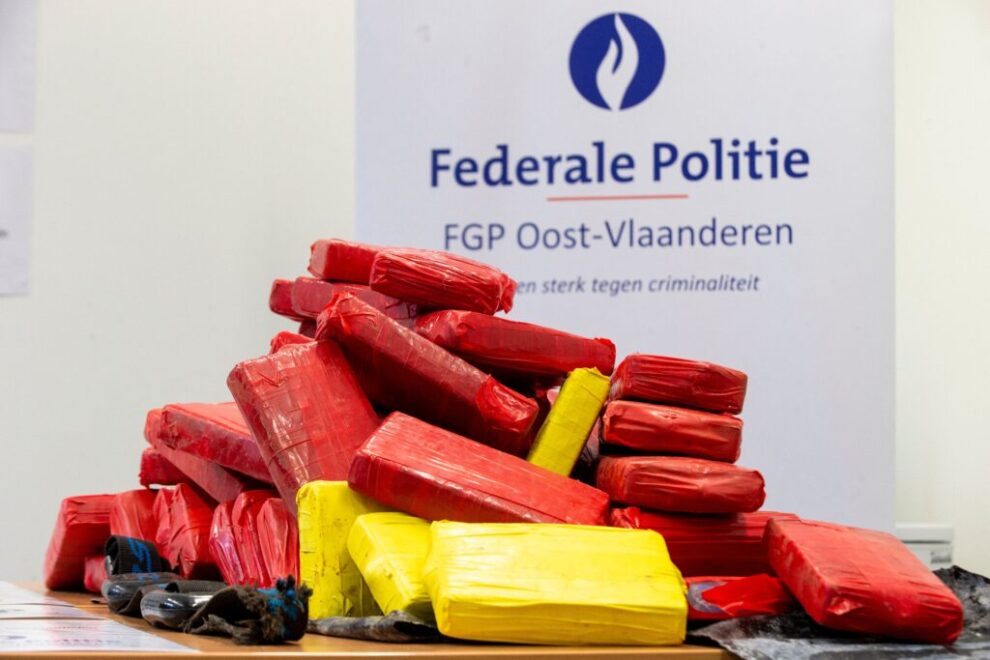BRUSSELS — Around here, no one wants to work the night shift.
Karim H’Didouane has for two years been a receptionist at the Park Inn by Radisson next to the Brussels Midi railway station, known as Zuid in Flemish. The area is changing, he said — and not for the better.
“There’s an increase of drug dealers, vandalism, stealing,” H’Didouane said. “It’s not safe at any moment.”
Park Inn sits across the road from one of Brussels Midi’s entrances, in an area of the city’s Saint-Gilles district which has garnered a reputation for violence and crime, particularly when darkness falls.
H’Didouane isn’t the only one who feels unsafe. A few feet from Park Inn, Mostafa Abdelazim, receptionist at Euro Capital hotel, has had his wallet stolen five times in five years.
“[It’s] not the best image for when international travelers arrive at the station,” he said. “Most of them arrive [at the hotel] already with a problem: ‘someone stole my bag’ … or ‘I’ve been attacked.’”
On a warm summer afternoon, the station — Belgium’s main railway hub for domestic and international journeys — seems safe enough, alive with tourists rushing to catch their trains, locals flocking underground to the metro and retailers selling everything from food to colorful décor to expensive bags. But by night, the local receptionists paint a hellish scene: broken car windows, persistent pickpocketing, stolen bicycles, drunken and narcotic-induced fights.
What they are seeing is a disturbing trend that has been shaking up the city. It’s gotten so bad, in fact, that on Wednesday 40 Brussels neighborhood committees and associations sounded the alarm about drug use and decreasing safety in an open letter to politicians, distributed by local press.
New police data released by Belgian Interior Minister Annelies Verlinden, at the request of Flemish conservative N-VA MP Tomas Roggeman, shows that Saint-Gilles is a hotspot for crime.
According to the figures, police recorded 3,320 crimes near the station in 2021 and 3,447 crimes during COVID-riddled 2020, with the most common offenses being theft and extortion. In 2019, the number was 4,205, while in 2018 it was lower, at 2,815. The 2022 figures are not complete, but the first nine months saw 2,204 crimes.
According to Belgium’s De Standaard daily, the numbers mean the Midi station area had almost as many criminal offenses as all stations in 13 Flemish cities — including Antwerp and Ghent — put together.
“It wasn’t a surprise to me that there was a lot of criminality in general in Brussels, but what struck me was the size of the issues,” Roggeman said.
“This is a disgrace as Brussels South serves as the gateway for most of the international railway traffic, being a hub of Eurostar and Thalys,” he added.
Another number stands out, one which has been steadily growing for the past five years: drug-related crimes. In 2021, there were 372 drug-related offenses in the neighborhood around the station, more than one per day and constituting about 10 percent of overall crimes that year. This is an increase from the 266 reported in 2020, 172 in 2019, and 67 in 2018.
To those working around the station, the figures are not a surprise. H’Didouane said he has seen more drug dealers working in the area in the past five years, often trying to sneak onto hotel property and book rooms to sell or use narcotics.
And they shouldn’t be a surprise to government officials either. Drug use across Belgium has skyrocketed in recent years, from a rise in amphetamine use in 2022 to an increase in cocaine consumption in Brussels in 2021-2022.
In particular, crack cocaine — a highly addictive substance which first boomed in the U.S. in the 1980s — has started flooding the streets, becoming increasingly popular among drug users.
A 2021 analysis of municipal wastewater in 13 European cities, by the EU-funded EUSEME project, found the highest amounts of crack residues in Amsterdam and Antwerp, the Belgian port city that funnels mountains of illicit drugs, particularly cocaine, into continental Europe every year.
Crack has made its way to Brussels too. Survey data from Transit, a local help center and shelter for people with drug and alcohol addiction, found that crack was the most consumed substance among hard drug takers in 2022, used by 67 percent of people surveyed.
“Crack is cocaine, it’s just consumed in a different way,” Bruno Valkeneers, head of communications at Transit, said. “Doing a line or injecting yourself on the sidewalk is a lot harder than having a rock that is ready, putting it in a pipe and smoking its fumes.”
Crack cocaine is a drug obtained by combining cocaine powder with baking soda or ammonia. It turns the product into solidified rocks, which can be smoked with a glass pipe. It’s not just easier to consume than cocaine, but crack is also cheaper — one rock of crack costs between €10 and €20. This has contributed to its rising popularity in recent years.
Pauline Goeminne, a spokesperson for Brussels Health Minister Alain Maron from the French-speaking green party Ecolo, said drug data is difficult to assess, but overall confirmed that the city is seeing an increase in crack consumption and a decrease in the use of heroin.
“We are well aware of the problem, and we have already been putting solutions in place with Ministers Vervoort and Van den Brandt, as well as other stakeholders,” Goeminne said, referring to the Brussels city minister-president and mobility minister. “But the problem is on such a scale, as it is in many major cities, that additional resources and new solutions need to be put in place.”
The Belgian government has been tentatively fighting back against drug trafficking and drug-related violence. Earlier this year, the country presented a new plan to fight drug violence, including bolstering police presence in ports, ramping up scanning infrastructure, screening all port workers’ criminal records and financial status, and increasing fines for cocaine users.
They also appointed Ine Van Wymersch as the country’s first drug commissioner, tasked with tackling drug crime.
It’s not just hardline law and order, though. In 2022, the city opened its first drug consumption venue in Brussels, near the Midi station, which allows users to safely consume drugs. In the space, co-run by Transit, users can access clean supplies, monitor their health, and consult nurses and social workers.
Brandon Siemes, 26, is a regular visitor to the consumption room.
“Here, you can come and use [drugs], no one’s judging you,” said Siemes, who has been using since he was 15 years old. “The staff are friendly, very very welcoming. When you need to talk, they listen, they give you advice, they’re going to try to find solutions … It goes a long way.”
Goeminne, the health minister’s spokesperson, said a drug consumption room “that complies with the regulatory criteria offers guarantees of success at various levels,” based on recommendations and analyses conducted on the spaces. Opening a second consumption room close to the areas most affected by drug taking remains a “preferred option” when talking about solutions.
For Valkeneers from Transit, the war on drugs simply does not work: prohibiting and criminalizing drugs has no impact on product availability.
“Drug users do not have blood on their hands, and are certainly not responsible for drug trafficking, because that would mean that demand conditions the supply,” he said. “But that’s clearly not the case: It’s the supply that is abundant, and that conditions the demand.”
Others disagree. To Roggeman, the Flemish MP, consumption rooms only combat the symptoms of the problem, not its roots.
“Brussels has a very soft policy on drugs,” he said. “We need a tougher stance on drugs, we need to sanction drug users and drug traffickers.”
Saint-Gilles is not the only neighborhood in the city struggling to keep up with its drug problem. Areas around other big stations in Brussels also showed a steady increase in the number of drug-related offenses, according to the data released by Verlinden.
Ribaucourt and Yser on the edge of the city center have also seen more widespread drug use. To tackle this issue, Brussels Minister-President Rudi Vervoort announced Wednesday his intention to meet with a delegation of citizens and associations next Friday.
In the meantime, criminality at Brussels Midi continues to make headlines.
Last week, Sophie Dutordoir, CEO of Belgian railway company SNCB, appealed to politicians in a letter, asking for help tackling the “dramatic situation” at Brussels Midi.
In the letter — which was sent to Vervoort, Belgian Mobility Minister Georges Gilkinet, Verlinden and the mayors Jean Spinette of Saint-Gilles and Fabrice Cumps of Anderlecht (the region bordering the northwest side of Brussels Midi) — Dutordoir said more needs to be done to address the station’s problems, from cleanliness to safety.
It’s not just the employees’ safety that’s being threatened; the area’s reputation is starting to affect business too.
Saleem Nayani, manager of Hotel Continental by Midi, said he has seen the number of clients dip 25 percent in the past three years, with many tourists lamenting the safety of the area and opting for accommodation closer to the city’s center.
And according to H’Didouane at the Park Inn, clients more frequently leave negative reviews about their stays, complaining about the location’s atmosphere and vibe. To him, much more still needs to be done.
“Sometimes we call the police and they are coming three or four hours later,” he said. “We feel that we are left alone.”
Source: POLITICO



































